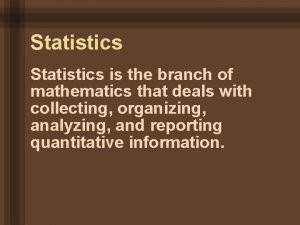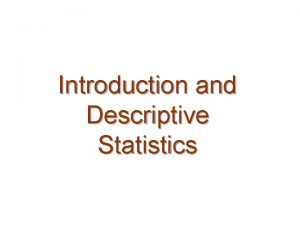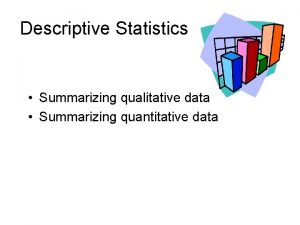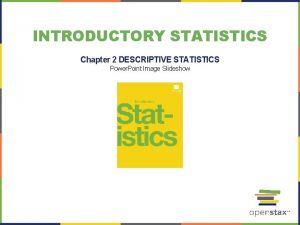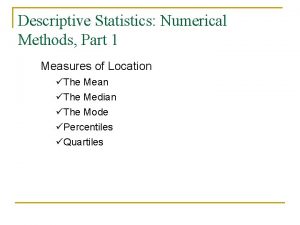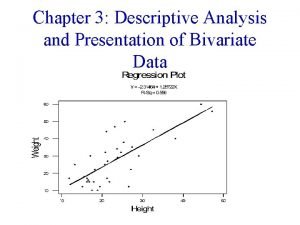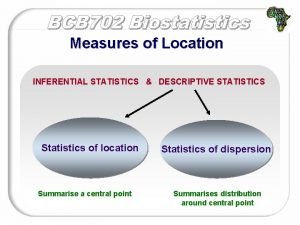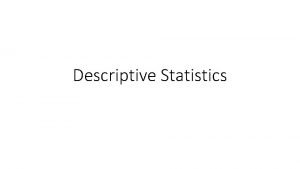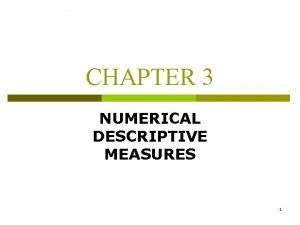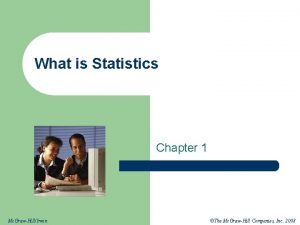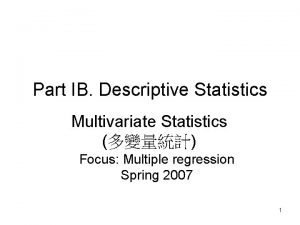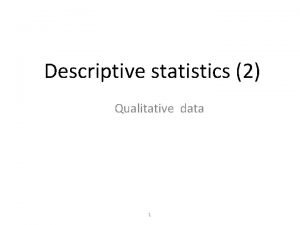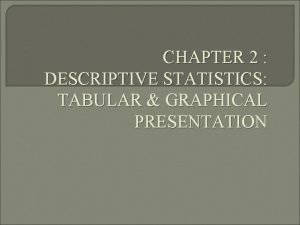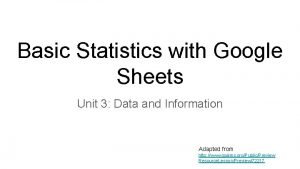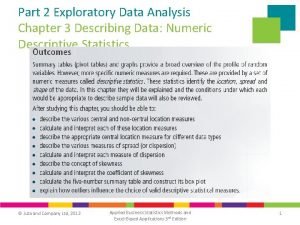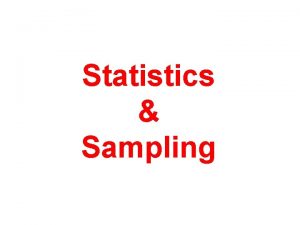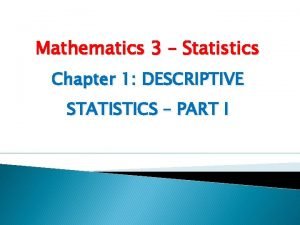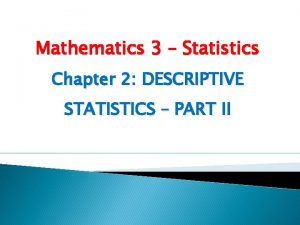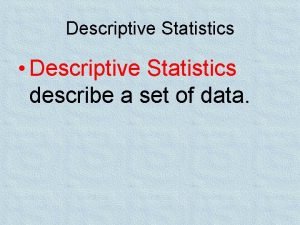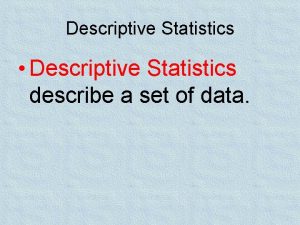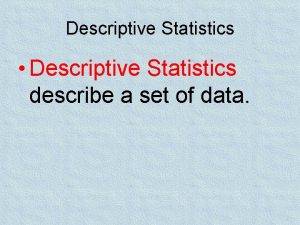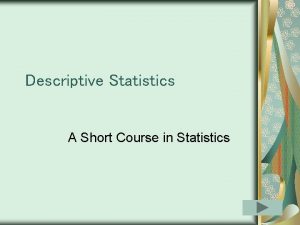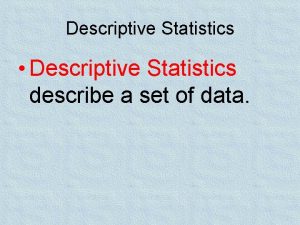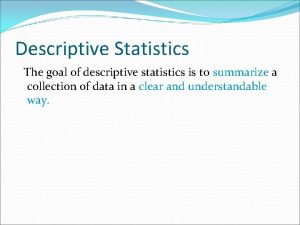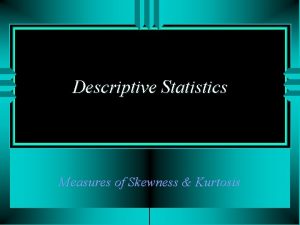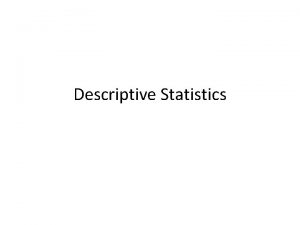Mathematics Statistics Part I Descriptive Statistics Topic 1














































- Slides: 46

Mathematics & Statistics Part I: Descriptive Statistics Topic 1 Why Study Statistics?

Study Goals After this topic, you should be able to: n n Explain how decisions are often based on incomplete information Explain key definitions: Population vs. Sample Parameter vs. Statistic Descriptive vs. Inferential Statistics n n Describe random sampling Explain the difference between Descriptive and Inferential statistics

Dealing with Uncertainty Everyday decisions are based on incomplete information Consider: n n The price of Ryan. Air stock will be higher in six months than it is now. If the budget deficit is as high as predicted, interest rates will remain high for the rest of the year.

Dealing with Uncertainty (continued) Because of uncertainty, the statements should be modified: n n The price of Ryan. Air stock is likely to be higher in six months than it is now. If the budget deficit is as high as predicted, it is probable that interest rates will remain high for the rest of the year.

Key Definitions n A population is the collection of all items of interest or under investigation n n N represents the population size A sample is an observed subset of the population n n represents the sample size n A parameter is a specific characteristic of a population n A statistic is a specific characteristic of a sample

Population vs. Sample Population a b Sample cd b ef gh i jk l m n o p q rs t u v w x y z Values calculated using population data are called parameters c gi o n r u y Values computed from sample data are called statistics

Examples of Populations n Names of all registered voters in Ireland n Incomes of all families living in Dublin n n Annual returns of all stocks traded on the New York Stock Exchange Grade point averages of all students in the BESS degree

Random Sampling Simple random sampling is a procedure in which each member of the population is chosen strictly by chance, n each member of the population is equally likely to be chosen, and n every possible sample of n objects is equally likely to be chosen n The resulting sample is called a random sample

Descriptive and Inferential Statistics Two branches of statistics: n Descriptive statistics n n Collecting, summarizing, and processing data to transform data into information Inferential statistics n provide the basis for predictions, forecasts, and estimates that are used to transform information about samples into inferences about populations

Descriptive Statistics n Collect data n n Present data n n e. g. , Survey e. g. , Tables and graphs Summarize data n e. g. , Sample mean =

Inferential Statistics n Estimation n n e. g. , Estimate the population mean weight using the sample mean weight Hypothesis testing n e. g. , Test the claim that the population mean weight is 60 kgs Inference is the process of drawing conclusions or making decisions about a population based on sample results

The Decision Making Process Decision Inferences Experience, Theory, Literature, Inferential Statistics, Computers Information Descriptive Statistics, Probability, Computers Begin Here: Identify the Problem Data

Topic Summary n n Reviewed incomplete information in decision making Introduced key definitions: n Population vs. Sample n Parameter vs. Statistic n Descriptive vs. Inferential statistics Described random sampling Examined the decision making process

Mathematics &Statistics Topic 2 Describing Data: Graphical

Topic Goals After completing this topic, you should be able to: n n n Identify types of data and levels of measurement Create and interpret graphs to describe categorical variables: n frequency distribution, bar chart, pie chart, Pareto diagram Create a line chart to describe time-series data Create and interpret graphs to describe numerical variables: n frequency distribution, histogram, ogive Construct and interpret graphs to describe relationships between variables: n Scatter plot, cross table Describe appropriate and inappropriate ways to display data graphically

Types of Data Categorical Numerical Examples: n n n Marital Status Are you registered to vote? Eye Color (Defined categories or groups) Discrete Examples: n n Number of Children Defects per hour (Counted items) Continuous Examples: n n Weight Voltage (Measured characteristics)

Graphical Presentation of Data n n n Data in raw form are usually not easy to use for decision making Some type of organization is needed n Table n Graph The type of graph to use depends on the variable being summarized

Graphical Presentation of Data (continued) n Techniques reviewed in this topic: Categorical Variables • Frequency distribution • Bar chart • Pie chart • Pareto diagram Numerical Variables • Line chart • Frequency distribution • Histogram and ogive • Scatter plot

Tables and Graphs for Categorical Variables Categorical Data Tabulating Data Frequency Distribution Table Graphing Data Bar Chart Pie Chart Pareto Diagram

The Frequency Distribution Table Summarize data by category Example: Hospital Patients by Unit Hospital Unit Cardiac Care Emergency Intensive Care Maternity Surgery (Variables are categorical) Number of Patients 1, 052 2, 245 340 552 4, 630

Bar and Pie Charts n n Bar charts and Pie charts are often used for qualitative (category) data Height of bar or size of pie slice shows the frequency or percentage for each category

Pie Chart Example Hospital Unit Cardiac Care Emergency Intensive Care Maternity Surgery Number of Patients % of Total 1, 052 2, 245 340 552 4, 630 11. 93 25. 46 3. 86 6. 26 52. 50 (Percentages are rounded to the nearest percent)

Pareto Diagram n n Used to portray categorical data A bar chart, where categories are shown in descending order of frequency A cumulative polygon is often shown in the same graph Used to separate the “vital few” from the “trivial many”

Pareto Diagram Example: 400 defective items are examined for cause of defect: Source of Manufacturing Error Number of defects Bad Weld 34 Poor Alignment 223 Missing Part 25 Paint Flaw 78 Electrical Short 19 Cracked case 21 Total 400

Graphs for Time-Series Data n n n A line chart (time-series plot) is used to show the values of a variable over time Time is measured on the horizontal axis The variable of interest is measured on the vertical axis

Line Chart Example

Graphs to Describe Numerical Variables Numerical Data Frequency Distributions and Cumulative Distributions Histogram Ogive Stem-and-Leaf Display

Frequency Distributions What is a Frequency Distribution? n n n A frequency distribution is a list or a table … containing class groupings (categories or ranges within which the data fall). . . and the corresponding frequencies with which data fall within each class or category

Why Use Frequency Distributions? n n n A frequency distribution is a way to summarize data The distribution condenses the raw data into a more useful form. . . and allows for a quick visual interpretation of the data

Class Intervals and Class Boundaries n n Each class grouping has the same width Determine the width of each interval by n n n Use at least 5 but no more than 15 -20 intervals Intervals never overlap Round up the interval width to get desirable interval endpoints

Frequency Distribution Example: The number of passengers on a typical Dublin Bus line during a particular day for 20 different services are: 24, 35, 17, 21, 24, 37, 26, 46, 58, 30, 32, 13, 12, 38, 41, 43, 44, 27, 53, 27

Histogram n n A graph of the data in a frequency distribution is called a histogram The interval endpoints are shown on the horizontal axis the vertical axis is either frequency, relative frequency, or percentage Bars of the appropriate heights are used to represent the number of observations within each class

Questions for Grouping Data into Intervals n 1. How wide should each interval be? (How many classes should be used? ) n 2. How should the endpoints of the intervals be determined? n n n Often answered by trial and error, subject to user judgment The goal is to create a distribution that is neither too "jagged" nor too "blocky” Goal is to appropriately show the pattern of variation in the data

How Many Class Intervals? n Many (Narrow class intervals) n n n may yield a very jagged distribution with gaps from empty classes Can give a poor indication of how frequency varies across classes Few (Wide class intervals) n n may compress variation too much and yield a blocky distribution can obscure important patterns of variation. (X axis labels are upper class endpoints)

Distribution Shape n The shape of the distribution is said to be symmetric if the observations are balanced, or evenly distributed, about the center.

Distribution Shape (continued) n The shape of the distribution is said to be skewed if the observations are not symmetrically distributed around the center. A positively skewed distribution (skewed to the right) has a tail that extends to the right in the direction of positive values. A negatively skewed distribution (skewed to the left) has a tail that extends to the left in the direction of negative values.

Relationships Between Variables n n Graphs illustrated so far have involved only a single variable When two variables exist other techniques are used: Categorical (Qualitative) Variables Numerical (Quantitative) Variables Cross tables Scatter plots

Scatter Diagrams n n Scatter Diagrams are used for paired observations taken from two numerical variables The Scatter Diagram: n one variable is measured on the vertical axis and the other variable is measured on the horizontal axis

Scatter Diagram Example Volume per day Cost per day 23 125 26 140 29 146 33 160 38 167 42 170 50 188 55 195 60 200

Cross Tables n n Cross Tables (or contingency tables) list the number of observations for every combination of values for two categorical or ordinal variables If there are r categories for the first variable (rows) and c categories for the second variable (columns), the table is called an r x c cross table

Cross Table Example n 4 x 3 Cross Table for Investment Choices by Investor (values in $1000’s) Investment Category Investor A Investor B Investor C Total Stocks 46. 5 55 27. 5 129 Bonds CD Savings 32. 0 15. 5 16. 0 44 20 28 19. 0 13. 5 7. 0 95 49 51 Total 110. 0 147 67. 0 324

Graphing Multivariate Categorical Data (continued) n Side by side bar charts

Side-by-Side Chart Example n Sales by quarter for three sales territories:

Data Presentation Errors Goals for effective data presentation: n Present data to display essential information n Communicate complex ideas clearly and accurately n Avoid distortion that might convey the wrong message

Data Presentation Errors (continued) n n Unequal histogram interval widths Compressing or distorting the vertical axis Providing no zero point on the vertical axis Failing to provide a relative basis in comparing data between groups

Topic Summary n n Reviewed types of data and measurement levels Data in raw form are usually not easy to use for decision making -- Some type of organization is needed: Table n Graph Techniques reviewed in this chapter: n n Frequency distribution Bar chart Pie chart Pareto diagram n n n Line chart Frequency distribution Histogram and ogive Scatter plot Cross tables and side-by-side bar charts
 Topic 3 the mathematics of formulas and equations
Topic 3 the mathematics of formulas and equations Clincher in writing
Clincher in writing Narrowing down a topic exercises
Narrowing down a topic exercises Statistics is a branch of
Statistics is a branch of Introduction to business mathematics ppt
Introduction to business mathematics ppt Transition to college mathematics and statistics pdf
Transition to college mathematics and statistics pdf What is the value of σx2 for the scores 1, 0, 2, 4?
What is the value of σx2 for the scores 1, 0, 2, 4? Descriptive hypothesis
Descriptive hypothesis Example of descriptive statistics
Example of descriptive statistics Descriptive statistics ap psychology
Descriptive statistics ap psychology Introduction to descriptive statistics
Introduction to descriptive statistics How to graph qualitative data
How to graph qualitative data Chapter 2 descriptive statistics answer key
Chapter 2 descriptive statistics answer key Numerical descriptive statistics
Numerical descriptive statistics Descriptive statistics numerical measures
Descriptive statistics numerical measures Bivariate descriptive statistics
Bivariate descriptive statistics Measure of location statistics
Measure of location statistics Kinds of descriptive statistics
Kinds of descriptive statistics Numerical descriptive techniques
Numerical descriptive techniques Standard deviation formula for ungrouped data
Standard deviation formula for ungrouped data Descriptive statistics definition
Descriptive statistics definition Descriptive statistics
Descriptive statistics Definition of descriptive statistics
Definition of descriptive statistics Multivariate descriptive statistics
Multivariate descriptive statistics Categorical frequency distribution example
Categorical frequency distribution example Descriptive statistics
Descriptive statistics Descriptive statistics classification
Descriptive statistics classification Descriptve
Descriptve Descriptive statistics google sheets
Descriptive statistics google sheets Section 2 topic 1 linear equations in one variable part 1
Section 2 topic 1 linear equations in one variable part 1 Chapter 2 equations in one variable
Chapter 2 equations in one variable 1.topic/title:
1.topic/title: Two part of topic sentence
Two part of topic sentence Introduction to statistics what is statistics
Introduction to statistics what is statistics Business statistics i com part 2 chapter 3
Business statistics i com part 2 chapter 3 Part whole model subtraction
Part whole model subtraction Part to part ratio definition
Part to part ratio definition Brainpop ratios
Brainpop ratios What is a technical description?
What is a technical description? Vodka chimney glass
Vodka chimney glass The phase of the moon you see depends on ______.
The phase of the moon you see depends on ______. Minitab adalah
Minitab adalah Mathematics timetable
Mathematics timetable As a laboratory assistant you measure chemicals
As a laboratory assistant you measure chemicals Wisconsin math council
Wisconsin math council Where mathematics comes from
Where mathematics comes from Asma math competition
Asma math competition



